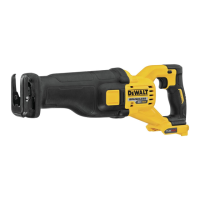11
ENGLISH
Variable Speed Trigger Switch (Fig. C)
Lock‑off Button and Trigger switch
Your saw is equipped with a lock‑off button
2
.
To lock the trigger switch, press the lock‑off button as shown
in Figure C. Always lock the trigger switch
1
when carrying or
storing the tool to eliminate unintentional starting. The lock‑off
button is colored red to indicate when the switch is in its
unlockedposition.
Proper Hand Position (Fig. D)
WARNING: To reduce the risk of serious personal injury,
ALWAYS use proper hand position asshown.
WARNING: To reduce the risk of serious personal
injury, ALWAYS hold securely in anticipation of a
suddenreaction.
Proper hand position requires one hand on the hand grip
6
,
with the other hand on the main handle
5
.
OPERATION
Instructions for Use
WARNING: Always observe the safety instructions and
applicableregulations.
WARNING: To reduce the risk of serious personal
injury, turn tool off and disconnect battery pack
before making any adjustments or removing/
installing attachments or accessories. An accidental
start‑up can causeinjury.
Blade Installation and Removal
(Fig. A, E–G)
Different blade lengths are available. Use the appropriate blade
for the application. The blade should be longer than 90mm and
should extend past the shoe and the thickness of the workpiece
during the cut. Do not use jigsaw blades with thistool.
WARNING: Cut hazard. Blade breakage may occur if the
blade does not extend past the shoe and the workpiece
during the cut (Fig. B). Increased risk of personal injury, as
well as damage to the shoe and workpiece mayresult.
To Install Blade into Saw
1. Pull blade clamp release lever
3
up (Fig.C).
2. Insert blade shank from thefront.
3. Push blade clamp release leverdown.
NOTE: The blade can be installed in two positions as shown in
Figure G.
To Remove Blade from Saw
CAUTION: Burn hazard. Do not touch the blade
immediately after use. Contact with the blade may result
in personalinjury.
1. Open up blade clamp releaselever.
2. Removeblade.
Inserting and Removing the Battery Pack
from the Tool (Fig. B)
NOTE: Make sure your battery pack
7
is fullycharged.
To Install the Battery Pack into the Tool Handle
1. Align the battery pack
7
with the rails inside the tool’s
handle (Fig. B).
2. Slide it into the handle until the battery pack is firmly seated
in the tool and ensure that you hear the lock snap intoplace.
To Remove the Battery Pack from the Tool
1. Press the release button
8
and firmly pull the battery pack
out of the toolhandle.
2. Insert battery pack into the charger as described in the
charger section of thismanual.
Fuel Gauge Battery Packs (Fig.B)
Some DeWALT battery packs include a fuel gauge which
consists of three green LED lights that indicate the level of
charge remaining in the batterypack.
To actuate the fuel gauge
11
, press and hold the fuel gauge
button. A combination of the three green LED lights will
illuminate designating the level of charge left. When the level
of charge in the battery is below the usable limit, the fuel gauge
will not illuminate and the battery will need to berecharged.
NOTE: The fuel gauge is only an indication of the charge left on
the battery pack. It does not indicate tool functionality and is
subject to variation based on product components, temperature
and end‑userapplication.
ASSEMBLY AND ADJUSTMENTS
WARNING: To reduce the risk of serious personal
injury, turn tool off and disconnect battery pack
before making any adjustments or removing/
installing attachments or accessories. An accidental
start‑up can causeinjury.
WARNING: Use only DeWALT battery packs andchargers.
DO NOT use under wet conditions or in presence of flammable
liquids orgases.
These reciprocating saws are professional powertools.
DO NOT let children come into contact with the tool.
Supervision is required when inexperienced operators use
thistool.
• Young children and the infirm. This appliance is not
intended for use by young children or infirm persons
withoutsupervision.
• This product is not intended for use by persons (including
children) suffering from diminished physical, sensory or
mental abilities; lack of experience, knowledge or skills
unless they are supervised by a person responsible for their
safety. Children should never be left alone with thisproduct.

